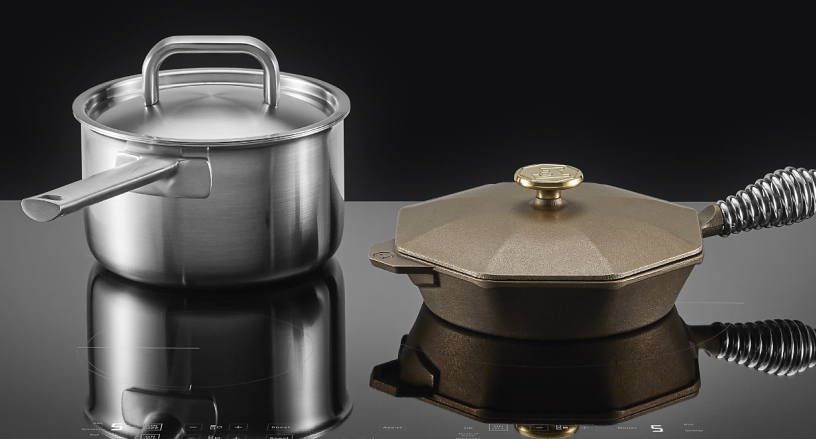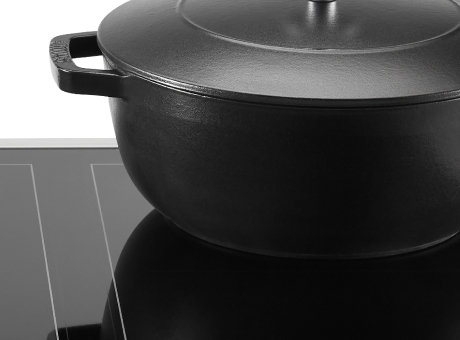

If you are looking to replace or upgrade your cooking appliance, you may choose to go with an electric range or cooktop. If so, there are three options on the market: radiant, induction and coil.
Induction ranges or cooktops have grown in popularity because they tend to be highly efficient, offer easy cleanup and are able to reach a boil or drop in temperature quickly. The typical result is faster cooking, especially in pots, with water coming to a boil sooner.
This guide will walk you through the basics: what induction is, how induction cooking works, induction cookware, how to test for compatibility, the benefit of induction cooking and more.


WHAT IS INDUCTION COOKING?
There are several types of induction appliances, including cooktops, commercial rangetops and ranges/stoves. The first thing to know about Induction cooktops or ranges is that they are fueled by electricity.
Induction ranges or cooktops are considered to be one of the most efficient cooking technologies as they heat the cookware directly, not the cooking surface, as is the case with other electric cooktop or range options. By turning the cookware into the heat source, owners can effectively cook at either high or low heat.
An example of efficiency is that, when boiling water, the JennAir® induction cooktops, compared to its radiant and gas cooktops, generally had:
- Improved energy efficiency (defined as the percentage of energy effectively used to boil water) of 75% vs 57% for radiant and 36% for gas.
- A 25% savings of time vs radiant, and 45-52% with respect to gas units.
- Reduced energy consumption (defined as the total energy consumed to boil water) of 285Wh vs 402 Wh for radiant.
Other electric ranges or cooktops, like open coil-type cooking tops and smooth cooking tops, offer less efficiency with respect to heat transfer. This is due to the heat first being transferred to the cooking surface and then to the cooking vessel.
Induction cooktops or ranges use electricity yet produce heat through electromagnets. This not only makes them a safer option but it also enables an increase in cooking speed, offers greater temperature control and is easier to clean than gas or electric ranges or cooktops.
Induction cooking requires either an induction range top or an induction cooktop.


INDUCTION COOKTOPs AND HOW THEY WORK
A copper coil, located under the cooktop, generates electromagnetic energy and enables an induction range or cooktop to work. Heat occurs when magnetic energy interacts with compatible cookware.
This technology achieves a quicker cook time and produces food that is more evenly cooked. It also allows the cooktop to quickly cool down once the pan is removed.
PRO TIP: We strongly recommend keeping a close eye on what you’re cooking the first few times you use a new induction cooktop or range. This will go a long way to helping you adapt to this cooking method’s speed.
COOKTOPS VS. RANGES
Induction ranges and cooktops are fueled by electricity. Cooktops are installed in the countertop with the controls situated on its horizontal plane. Induction ranges feature an induction range top built into it, and offer the same benefits as an induction cooktop.
INDUCTION COOKWARE: WHICH POTS AND PANS WORK BEST?
In general, what is paramount with cookware is the number of layers that the cookware is made of. One of these layers will typically be made of aluminum to help uniformly spread the heat. This in addition to other factors like their thickness, play an important role in the cookware’s performance in regards to:
- Pan detection
- Heating spread
- Ability to reach maximum power
- Heating retention
- Heat uniformity
Pots are a vital component of the induction system as it actively defines the electrical response. One drawback to induction ranges or cooktops, though, is that they are only compatible with special types of cookware.
Compatible cookware material designed for induction cooking.
Compatible cookware material designed for induction cooking.

What enables induction technology to work on a specific pot is a layer that reacts to the magnetic field. This means that induction cooking can only work with magnetic or ferromagnetic cookware. This type of cookware has a layer made of a stainless steel magnetic material that comes in contact with the cooktop glass and turns the cookware into a viable heat source. Non-magnetic and non-ferromagnetic cookware will not heat up on an induction cooktop or range. The burner will not detect the cookware and, in turn, the cookware will not interact with the electromagnetic energy that the burner generates.
Compatible induction cookware materials include enameled steel, cast iron and stainless steel designed for induction cooking.
Non-compatible induction cookware materials include glass, ceramic and certain copper or aluminum pans.
PRO TIP: The ply-type (number of layers) of cookware does not affect how efficient an induction cooktop will be. They do affect a cookware’s ability to evenly distribute heat. What this means is that you may experience better performance with 5-ply rather than 3-ply. Of course, it also means that induction can further enhance the performance of the cookware
HOW TO TEST IF YOUR COOKWARE IS INDUCTION COMPATIBLE
For optimal heat conduction, cookware with a flat bottom that is about the same size as the surface area of the burner is best as it allows for direct contact with the range or cooktop.
If the pan is too small for the element, the burner may not be able to detect the pan and won’t generate any heat. If the pan is too large, heat will only generate where the burner makes direct contact with the pan resulting in uneven cooking.
Test if cookware is induction compatible by doing one of the following:
- Flip the pan over, hold a magnet to the bottom, and see if it sticks. If the magnet does stick to the bottom, then it is ferromagnetic and is viable for induction cooking.
- Look at the bottom of your cookware. If you see a stamped coiled spring symbol this indicates induction compatibility.
HOW TO CLEAN INDUCTION COOKING SURFACE
Induction ranges or cooktops are easy to clean because the cooktop doesn’t heat up. Common splatters and messes are less likely to burn onto the cooktop surface and can be wiped away after you’re done cooking.
Before cleaning your ceramic glass range or cooktop, note the following:
- The controls must be turned off.
- Always follow label instructions on cleaning products.
- Do not use steel wool, abrasive powder cleansers, chlorine bleach, rust remover or ammonia.
To remove burned on soil from the ceramic glass range or cooktop surface, follow these steps. Remember to consult your appliance product use and care instructions before beginning any task.
Step 1
REMOVE FOOD AND/OR RESIDUE WITH A SCRAPER DESIGNED FOR CERAMIC GLASS RANGES OR COOKTOPS
- For best results, clean while the range or cooktop is still warm, but not hot to the touch. We recommend wearing an oven mitt while performing this task.
- Hold the scraper at about a 45° angle against the glass surface and apply pressure to scrape the residue.
- Allow the cooktop or range to cool before starting the next step.




Step 2
APPLy A FEW DIME-SIZED DROPS OF A CERAMIC GLASS RANGE OR COOKTOP CLEANER SUCH AS AFFRESH® COOKTOP CLEANER, TO THE AREAS YOU WANT TO CLEAN.
- Rub the cleaner onto the range or cooktop surface using a cooktop scrubbing pad. Apply reasonable pressure to remove stubborn stains.
- Usually, you let the cleaner dry before starting the next step.
Step 3
POLISH WITH A CLEAN, DRY CLOTH OR PAPER TOWEL.
- Repeat the Steps 1 – 3 as needed for stubborn or burned on stains.
PRO TIP: Ambient heat from your cookware may incidentally heat your induction range or cooktop. It’s best to wait for the surface to cool before you start cleaning.


INDUCTION OR GAS OR ELECTRIC?
When comparing induction with either gas or other electric cooking appliances what matters most is the particular cooking needs and cooking style of the owner.
Here is a breakdown of how induction stacks up against gas and electric cooking appliances.
INDUCTION
GAS
ELECTRIC
INDUCTION VS. GAS
Gas ranges or cooktops are fueled by either natural gas or propane. This offers quick heating and precise burner control. Gas can help you achieve a nice sear or simmer and is ideal for wok cooking.
Induction cooktops or ranges are easier to clean than gas ranges or cooktops. This is because gas ranges or cooktops have grates and burner caps that need to be either removed or cleaned around whereas induction ranges or cooktops have a much easier to clean smooth surface.


INDUCTION VS. RADIANT VS. COIL COOKTOPS


RADIANT
Radiant cooktops or ranges have metal coils that heat quickly for the purposes of boiling and simmering. They are compatible with any type of cookware and are designed with expanding and contracting burners to better match your pot sizes. Select models of these cooktops have easy-to-clean ceramic cooking surfaces and a protective coating to avoid scratching.


COIL
Coil ranges or cooktops are typically more affordable than radiant and induction cooktops or ranges. However, they are considered to be more difficult to clean.


INDUCTION
One thing that most people don’t know about Induction ranges or cooktops is that when in operation they can produce a small hum or buzzing sound caused by a slight vibration. If you’re sensitive to sound then you may prefer gas or electric cooktops.
INDUCTION PRODUCTS
WHAT ARE THE BENEFITS OF INDUCTION COOKTOP?
Here is a summary of the benefits of induction cooking:
- Improved temperature control and cooking results
- Faster heating and cooking of foods
- Easy to clean
- According to the Department of Energy, induction cooktops or ranges can be up to 85% more efficient in energy transfer. This means that 85% of the energy goes directly to the cookware, creating a system based on efficiency and can lead to faster cooking times.
- The pot gets hot but the rangetop or cooktop doesn’t, making it a safe option.
- This technology releases less hot air into the kitchen. You should still use a hood vent for things like grease.
1) Energy.gov, last visited Oct 17, 2019.
Induction cooking is an efficient method to cook your favourite meals. Since this technology has been growing in popularity for decades, it may be time to ask yourself if you want to make the move to induction cooking.
ConTinue Reading
-
 Slide-in Vs Freestanding Range Freestanding ranges or slide-in ranges can be wonderful options for most kitchens. The decision typically comes down to personalization…
Slide-in Vs Freestanding Range Freestanding ranges or slide-in ranges can be wonderful options for most kitchens. The decision typically comes down to personalization… -
 Why Is My Dishwasher Not Starting What household doesn’t rely on their dishwasher? Every day, these kitchen appliances help us spend less time washing dishes and cleaning up…
Why Is My Dishwasher Not Starting What household doesn’t rely on their dishwasher? Every day, these kitchen appliances help us spend less time washing dishes and cleaning up… -
 What is a Column Refrigerator If you’re redesigning or renovating your kitchen, you may want a sleek and stunning built-in refrigerator to create a visual impact...
What is a Column Refrigerator If you’re redesigning or renovating your kitchen, you may want a sleek and stunning built-in refrigerator to create a visual impact...
Compare 0/3
